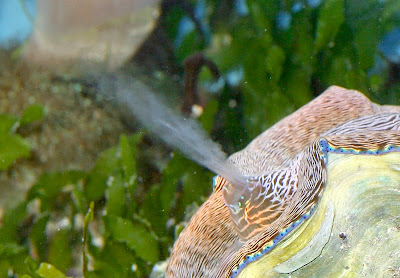Giant clams are the largest bivalve molluscs, and they live in the warm seas of the Indo-Pacific region. There are ten known species of giant clam. The dorsal body wall, or mantle, of all giant clam species is a habitat for a symbiotic photosynthetic algae (Gymnodinium microadriaticum), and during the day, a giant clam opens its shell and extends its mantle tissues so the symbiotic algae can receive sunlight needed for photosynthesis. Therefore, giant clams are only found in relatively shallow and clear waters, including those associated with coral reefs; the deepest known giant clam occurrence is 20 meters. Giant clams are filter feeders on particulate organic matter, and the metabolic products of their symbiotic algae provide them with an additional source of nutrition.
Depending on the species, a giant clam reaches maturity after 4 to 9 years. They reproduce sexually and produce both eggs and sperm, and they cannot self-fertilize. Through chemical signalling, many individuals synchronize the release of sperm and eggs into the water (broadcast spawning), and this helps ensure fertilization. Spawning seems to occur during incoming tides; spawning is intense for 30 minutes to two-and-a-half hours, with contractions occurring every 2 to 3 minutes.
A fertilized eggs floats in the sea for about 12 hours until hatching into a planktonic larva. It then begins to produce a calcium carbonate shell, and soon develops a "foot" which is used to move on the substrate. Larvae can also swim to find suitable habitat. Giant clam larvae do not host symbiotic algae, and rely completely on filter feeding. After about one week, the giant clam settles on the substrate, though frequently changing locations during the first weeks. The largest giant clam, Tridacna gigas, can grow to weigh over 200 kg, measure 120 cm in length, and has an average lifespan in the wild of 100 years or more.
The distribution of giant clams (figure 1) spans from south- and east Africa to the east Pacific beyond French Polynesia (between 30°E and 120°W), and from Japan to Australia (between 36°N and 30°S). Tridacna maxima has the widest distribution, and the greatest species diversity of giant clams is observed in the central Indo-Pacific. Seven species can be found in southeast Asia, but many populations are declining dramatically, and there are cases of local extinctions. Local extinctions of giant clam species have been reported in areas of the Philippines, Indonesia, Micronesia, Malaysia, and Singapore. Giant clams can be found throughout Oceania (Australasia, Melanasia, Micronesia, and Polynesia). While abundance of giant clams in Oceania has been declining, there are areas in Oceania with unusually high abundances, including the Ashmore, Cartier, and Mermaid reefs of Australia.
Figure 1: Distribution of giant clams. Blue triangles represent non-scientist observations where species is unknown.
Their numbers have been greatly reduced due to overharvesting and loss of habitat, and giant clams are also seriously affected by increasing sedimentation and pollution. Furthermore, increasing sea surface temperatures leads to the loss of symbiotic algae. Eight species of giant clam are red listed as conservation-dependent or vulnerable; another species, Tridacna costata, was only recently discovered and is therefore not yet listed, though "critically endangered" is the proposed appropriate category.
A number of countries including Tonga, Palau, Fiji, Soloman Islands, and Cook Islands, have attempted to restore giant clam populations through local aquaculture- and restocking programs. The Marine Science Institute (MSI) at the University of the Philippines has a long and successful record of rearing cultured giant clams to restore populations. The restocking of giant clams in the Philippines began in 1987 as interest grew among private and public sectors for establishing giant clam ocean nurseries. A collaborative research program for culturing bivalves was organized, the MSI being one of the participants in the program. Key objectives of the restocking program were to establish broodstocks and develop culturing techniques, with the aims of mass-production for restocking and creating livelihoods around giant clam farming.
Field surveys around the Philippines indicated that the 3 largest giant clam species were rare. In fact, only 2 wild sub-adult Tridacna gigas, and no Hippopus porcellanus, were found. Restocking started slowly, as only a limited number of giant clams were available to place in the wild, and restored populations initially suffered heavy losses due to poaching and illegal fishing. Eventually, individuals and groups teamed up to protect giant clams, and marine protected areas became regarded as suitable sites for restocking giant clams.
Scuba divers collected gametes (sperm and eggs) in plastic bags and took them to the boat where gametes of different individuals were mixed, thereby fertilizing the eggs. Hatchery-raised giant clams were released as juveniles throughout the Philippines, and stewards were trained to monitor the survival and growth of restocked clams. Giant clams have been restocked at more than 40 sites (figure 2) spread over more than 20 coastal provinces of the Philippines. The northern region (Luzon) has received the greatest number, as it is close to MSIs hatchery. The Hundred Islands National Park in the north has been another region of focus due to a special project funded by the Philippine Tourism Authority.
This giant clam restoration initiative has increased collaborator interest in protecting- and culturing giant clams, and improvements in practices and methods have provided valuable lessons to the restoration practitioners involved. One important lesson learned is that restoring giant clam populations must include the strong commitment of local communities.
LINK to Othman et al.'s 2010 article in The Raffles Bulletin of Zoology.
LINK to Gomez and Mingoa-Licuanan's 2006 article in Fisheries Research.





